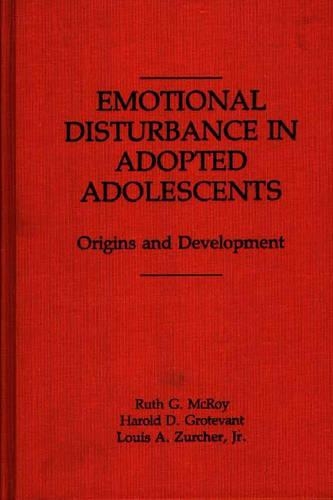
Emotional Disturbance in Adopted Adolescents: Origins and Development
(Hardback)
Publishing Details
Emotional Disturbance in Adopted Adolescents: Origins and Development
By (Author) Harold D. Grotevant
By (author) Ruth Mcroy
By (author) Susan Zurcher
Bloomsbury Publishing PLC
Praeger Publishers Inc
28th July 1988
United States
Classifications
Tertiary Education
Non Fiction
155.5
Physical Properties
Hardback
230
Width 152mm, Height 229mm
567g
Description
A report of research on two groups of residentially placed, emotionally disturbed adolescents compared on the basis of their adoptive status. A post hoc comparison with a nondisturbed adoptive group is also included. . . . McRoy, Grotevant, and Zurcher examine factors related to adoption that may contribute to the development of emotional difficulties. The authors' suggestions are worthy of consideration by professionals in the field. . . . The theoretical reviews of potential sources of difficulty in adoption are well done and informative, and the presentation of the perspectives of both adoptees and adoptive parents is also laudable. Choice Many adopted children experience emotional disorders during adolescence that require residential treatment. This volume reports research findings comparing adopted and non-adopted adolescents in treatment. The authors first discuss the difficulties of the adolescent period itself, particularly as it relates to identity problems. Based on extensive interviews with adoptive and non-adoptive parents, adolescents, and their therapists, successive chapters analyze genetic risk and prenatal care, explore the impact of family and peer relationships, examine familiar and contextual factors that initiate and maintain emotional problems, and examine adoptive family dynamics and adoption issues in nonclinical families. The various theoretical perspectives research findings, and well-reasoned recommendations in this volume will interest social workers, clinical and developmental psychologists, and special education professionals.
Reviews
A report of research on two groups of residentially placed, emotionally disturbed adolescents compared on the basis of their adoptive status. A post hoc comparison with a nondisturbed adoptive group is also included. Although the research revealed few statistically significant differences between the adopted group and the group raised by the biological parents, McRoy, Grotevant, and Zurcher examine factors related to adoption that may contribute to the development of emotional difficulties. The authors' suggestions are worthy of consideration by professionals in the field; however, because of the lack of group differences, they are based on a shaky foundation. The theoretical reviews of potential sources of difficulty in adoption are well done and informative, and the presentation of the perspectives of both adoptees and adoptive parents is also laudable.-Choice
"A report of research on two groups of residentially placed, emotionally disturbed adolescents compared on the basis of their adoptive status. A post hoc comparison with a nondisturbed adoptive group is also included. Although the research revealed few statistically significant differences between the adopted group and the group raised by the biological parents, McRoy, Grotevant, and Zurcher examine factors related to adoption that may contribute to the development of emotional difficulties. The authors' suggestions are worthy of consideration by professionals in the field; however, because of the lack of group differences, they are based on a shaky foundation. The theoretical reviews of potential sources of difficulty in adoption are well done and informative, and the presentation of the perspectives of both adoptees and adoptive parents is also laudable."-Choice
Author Bio
RUTH G. MCROY is Associate Professor of Social Work and Ruby Lee Piester Centennial Fellow in Services to Children and Families at the University of Texas at Austin. HAROLD D. GROTEVANT is Professor of Home Economics and Psychology and head of the division of Child Development and Family Relationships at the University of Texas at Austin. LOUIS A. ZURCHER, Jr., was Ashbel Smith Professor of Social Work and Sociology at the University of Texas, Austin.
